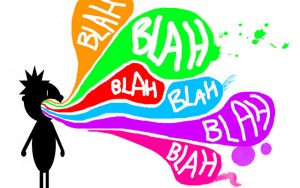Perlof explains that Kenneth Goldsmith discovers reporting on the “’truth’…may be the biggest ‘fiction’ of all” and I agree this is similar to the way nonfiction writers take “creative leniency” when dealing with various elements of a work. For example, like Goldsmith, it is difficult to pinpoint everything precisely and meticulously the way an interviewer may review their recordings to establish a narrative about a recent interview they were part of. The subject was wearing blue, but what shade of blue? Were his lips pink or face blushed? Do you remember and/or is it important to do so? More importantly, what happens when you embellish for sake of aesthetics?
What is fascinating about Goldsmith’s uncreative writing concept is that he is exploring the realm of what is digitally available to us. The influx of material and the overzealous execution/quantity o f that material is staggering. In my opinion, he’s opening up people to a commentary about our society and world from a zoomed-in, detailed view like his weather and traffic pieces, and asking us about our world of machines, of verbal garbage, of judgement and time perhaps. We live in a world where much of the time is spent receiving information that is “language more concerned with quantity than quality.”
f that material is staggering. In my opinion, he’s opening up people to a commentary about our society and world from a zoomed-in, detailed view like his weather and traffic pieces, and asking us about our world of machines, of verbal garbage, of judgement and time perhaps. We live in a world where much of the time is spent receiving information that is “language more concerned with quantity than quality.”
“Spiritus Sanctus Works, By Way of Words”
Vanessa Place has an inner battle going on between her creative and critical sections of herself. I see them as small creatures on her shoulders. Look at it through this lens…they both say to her. She cannot separate her passion for justice and her MFA. And why should she? Place approaches her work conceptually. Rule-oriented. Factual. She, like Goldsmith, work within the realm of the already stated, already created. In a bio piece from The Poetry Foundation she quotes Marcel Duchamp’s idea that “it’s not what you see that is art, art is the gap.” While I’ve not read the extent of her work to truly comment on it, I believe she’s attempting to strip down our language to the basic, human level. We base it on quantity, not quality again. Her poem “No More” is an excellent example of this, where she repeats “No more…” 18 times, adding concepts side-by-side that do not connect on the surface:
No more verbs of embroidery.
No more unintentional phallacy.
No more metaphor, no more simile. Let the thing be, concretely…
No more children pimped out to prove some outpouring mortality…
No more Gobstoppers: an epic isn’t an epic for its fingerprints…
I believe Place is commenting on the way we bend everything to fit into our boxes. Wordsmiths bend words to fit into advertising squares–create jargon to confuse and misuse the masses. When we think of who does this most successfully, I’d say it is people like lawyers and writers. At the same time, in the same space, Place begs to question what else coincides with our world that is flooded with the influx of manipulation? She uses a play on words of her own “unintentional phallacy” – commenting on a patriarchal, Western view, and a fallacy itself.
I think Place is purposeful and responsible within that purpose. I see the embargo on her by the creative world to simply be the little person that controls the creative, MFA side of them all. Place is questioning, is this creative side the devil? 🙂 Ok- that’s taking it a bit far, but does beg a bit of conversation.
I hope we’ll have the chance to discuss the Creative/Critical tension that you raise. I’m not sure quite how it works out in VP’s work and its reception. Does it have to do with the fact that she appropriates language (and in the case of GWTW, language that others find objectionable) ? Often readers’ first encounters with conceptual writing of any stripe will produce a negative reaction on the grounds that it’s insufficiently original, plagiaristic, too “easy” etc.